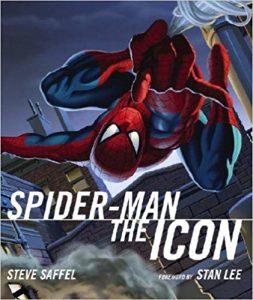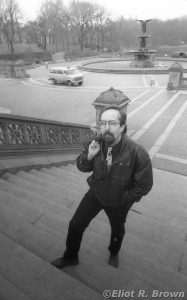Welcome back to An Interview from Behind the Universe by Nicholas Brown.
Today we have Steve Saffel, a man of many talents and a former marketing consultant for Marvel Comics!
He moved around to different companies, making connections and getting stuff done until he found his current spot as Senior Acquisitions Editor of Titans publishing company where he wrote the magnificent book, Spider-Man: The Icon.
From every interview I hope to get ammo to use against my father for his past misdeeds. Steve was not able to give me much but his first impressions of my father made me snort my coffee. But by any other practical measure, this interview was a lot of fun and I hope you all check out Steve Saffel on Facebook and keep an eye on his future projects and appearances!
And now, Steve Saffel:
Q: What did you do before working at Marvel Comics and do you think that helped prepare you for the job?
I earned a Bachelor’s degree in Journalism, which helped tremendously in developing communications and writing skills, and an appreciation for deadlines. My first job out of college was at the American Red Cross, and that provided me with much-needed perspective. As much as I’ve always loved comics, their importance pales when compared with making sure the regional hospital has enough blood on hand for an open-heart surgery. By not feeling as if I need to take comics as seriously, I can enjoy them with more pure delight.
Q: What has life been like after Marvel?
Life after Marvel has been diverse. I left Marvel to edit science fiction and fantasy at Del Rey Books, facing the challenge of novels that ranged from 80,000-175,000 words each. Yet I was able to make use of my Marvel experience. One of my earliest jobs at Marvel was to coordinate convention displays, and our Del Rey sales director was eager to display at San Diego Comic-Con. My contacts there made it easy to arrange a booth, and that was the beginning of exhibiting each year—something every major publisher has copied, and which continues to this day. Also at Del Rey I continued my connection with the comics realm by working on novels and nonfiction relating to the movie versions of Spider-Man, Hulk, X-Men, Star Wars, Babylon 5, Batman, and many more.
After Random House I joined Titan Books, where I helped to jump-start a vigorous fiction line. Titan is a major publisher, but not on the level of Random House, so it feels as if I can be more intimately involved with the projects I shepherd. At the beginning of my Titan stint, I also had the opportunity to write the heavily illustrated book SPIDER-MAN: THE ICON, which was tremendous fun.
This job gives me the opportunity to work closely with writers, and that’s one of the greatest gifts I could ask to receive. Creative people are wonderful, and the process is exciting beyond measure. I tend to be very involved with the work of my authors, sometimes leaving, as I like to say, “a lot of blood on the page.” This led one writer to bestow upon me a title—Dark Editorial Overlord. She meant it as a compliment, and I took it as such.
Q: Do you have any stories from the Bullpen that you’d like to tell? Perhaps something Eliot has overlooked in his writings or that you’d like to add to.
Mostly that the Bullpen was a great deal of fun, something that may have been blunted by modern publishing. Everyone came together with a sense of energy and fun, to create comics. The editorial offices surrounded the open area that was the Bullpen proper, and there was a constant hubbub, as designers, illustrators, letterers, colorists, and paste-up folks passed around materials in all degreed of completion (or lack of same). The Halloween parties were legendary, and the comradery was terrific.
I do recall the barely contained insanity that was Mark Gruenwald’s office. Mark loved everything about comics, and his enthusiasm washed over those around him. The offices had glass walls that faced into the bullpen, and Mark would block the view (or not) depending on what insidious thing he was engineering. Like the time he and his assistant editor decided to build bunk-desks, placing one above the other instead of both on the floor. Or the time they stopped taking out the trash, and crumpled wads of paper began to fill the office until Mark and his visitors were wading through it, waist deep (and clearly visible, as if the office was an aquarium).
[Editor’s note: Eliot claims that last part was part of a method of hiding from people by jumping under the wadded up comic scraps like a McDonald’s ballpit but sadly the original pictures, including Jack Morelli diving headfirst from a desk, have been lost to time though he intends to put up a diagram eventually for logistical purposes]
Some of the most treasured memories are of shooting the breeze with some of the most wonderful people, learning about the histories of my favorite comics creators. It was wonderful visiting George Roussos in his tiny, dimly lit office, and John Romita was one of the nicest people ever to walk the face of the earth. Knowing them was a treasure beyond measure.
Q: What got you to get into the comic industry in the first place?
I was a comics fan and reader from way back, and around my college years I worked on a number of science fiction conventions where we brought in comics guests, as well—including Stan Lee, Wendy and Richard Pini, and Jo Duffy. When Jo attended a convention we organized in Huntington, WV, she was accompanied by Carol Kalish, Marvel’s direct sales director. Carol and I stayed in touch, and when a publicity job opened up at Marvel, I pursued it. That took me to New York and my first job at Marvel.
Q: What was your first impression of Eliot?
We were somewhat peripheral to each other, but Eliot has always seemed larger than life. He had a strong and edged personality, a piercing voice, and a biting wit. He could be a bit frightening, and it was at times difficult to tell whether or not to take him seriously, but his love of comics was obvious. As someone who was close to Mark Gruenwald, he clearly hung out with the best in the business.
Q: Have you enjoyed seeing where Marvel has taken its characters in recent years? I’m referring specifically to the Marvel Cinematic Universe and its extended factions, but if you’ve kept up with Marvel Comics as well, I’m curious to hear your take.
I’m pretty far behind in my comics reading, but I’m fascinated by the way the new writers and artists seek to try new things and take chances. They don’t always appeal, but I try to remember that when comics were in their early days—as late as the 1960s and early 1970s—lots of folks didn’t expect them to last. They certainly didn’t expect anyone to have to deal with decades of back-story. It was simpler, back then, to just have fun with the characters. Today some people take it far too seriously, and in doing so lose the opportunity to just enjoy the medium.
It’s also difficult for some folks to realize that today so many other media can do what used to be exclusive to comics. Something like the Galactus trilogy in Fantastic Four or the Kree-Skrull War in The Avengers could only be done on the comics page, whereas today movies, television, and video games all offer platforms that can easily support such massive concepts. Comics still are wonderful, and I still love them, but they have to share the riches with media that often can perform better.
Having said that, the Marvel Cinematic Universe has been wonderful in developing the fundamental Marvel Comics concepts by following the template created by Stan Lee, Jack Kirby, Steve Ditko, Larry Lieber, Don Heck, John Romita, and so many more. By not being slavish to the comics continuity, and developing a separate and unique Marvel Universe, they’ve once again caught lightning in a bottle. Each and every movie and TV show has been fun in its own way. Similarly, the Marvel video games team has developed their own worlds, and I’ve had the good fortune of developing prequel novels to the Spider-Man and Avengers games released on Playstation.
Q: What was the most fun you had working on a project at Marvel?
Very hard to say. Perhaps SPIDER-MAN: THE ICON under license at Titan. However, the Captain America Collectors’ Special magazine, which I edited while on staff at Marvel, holds a special place in my heart. It allowed me to begin a friendship with Joe Simon, the co-creator of Captain America, and that lasted for many years. I’ll never forget sitting in Joe’s apartment watching an advance DVD of Captain America: The First Avenger.
Q: Is there anywhere our readers can find you on social media to keep up with you?
I’m pretty active on Facebook.
https://www.facebook.com/steve.saffel.3
Thank you, Steve! Be seeing you Readers, Nicholas Brown

